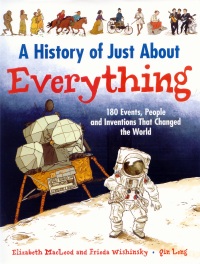| ________________
CM . . .
. Volume XX Number 7. . . .October 18, 2013
excerpt:
In this, their second collaboration (and quite an ambitious undertaking), authors MacLeod and Wishinsky have selected 180 world events, inventions and discoveries in the worlds of science, math, medicine, art, architecture and language, dating from six million BCE, when the first humans appeared on Earth, to the devastating tsunami in Japan in 2011. They have taken the difficult task of distilling the most pertinent facts about the event, person or discovery and explain them in kid-friendly language that readers will comprehend easily. The focus is on links to the past, how events which happened long ago shaped the future and continue to do so to this day. Each entry begins with the date and the heading/event, followed by several paragraphs about the topic, with space devoted to each entry ranging from one-third to one full page. Small text boxes, entitled “Ripples”, explain the ripple effect, i.e. how the event changed the world and affected future generations. To include these text boxes is a clever idea for it makes readers think, and their inclusion helps readers to better understand the world in which they live. For example, how did the invention of the automobile create suburbs, why hasn’t computer use led to the “paperless office” as was predicted, and how did the invention of the Internet spawn society’s interest in social media? Readers will be amazed at some of the information presented, such as the fact that the first cell phones weighed almost as much as a litre of milk, or that the first portable computers weighed more than 10 kg. Among others, topics in this book include early exploration, medical breakthroughs, space travel, natural and manmade disasters, political strife, wars, pop culture and transportation. How the authors narrowed their selection to 180 entries (and why is 180 the “magic” number?) remains a mystery and a marvel, and, for the most part, they have chosen well. However, the danger in creating such a list is that it is subjective, and some might argue that there are a few omissions and/or questionable inclusions. For instance, why write about Mozart, but not Beethoven, Kandinsky, but not Van Gogh, and why mention only Shakespeare, but no other authors? The phenomenal success of the Harry Potter books is featured, but no other books merit their own entries. A five-page timeline corresponds exactly to the various entries in the book and even provides page numbers for reference. Illustrations are detailed pen and watercolor drawings and maps that enhance, but do not overpower, the text. A table of contents and an index are also included. With just enough information to satisfactorily explain each topic, A History of Just About Everything not only serves to pique a child’s curiosity about world events, but it also demonstrates the relationship between the past and the present. Engaging, informative and entertaining. Highly Recommended. Gail Hamilton is a former teacher-librarian in Winnipeg, MB.
To comment
on this title or this review, send mail to cm@umanitoba.ca.
Copyright © the Manitoba Library Association. Reproduction for personal
use is permitted only if this copyright notice is maintained. Any
other reproduction is prohibited without permission.
NEXT REVIEW |
TABLE OF CONTENTS FOR THIS ISSUE
- October 18, 2013.
AUTHORS |
TITLES |
MEDIA REVIEWS |
PROFILES |
BACK ISSUES |
SEARCH |
CMARCHIVE |
HOME |
